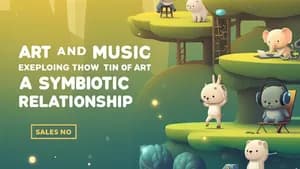Introduction: Bridging the Sensory Gap
Music, an intangible art form, exists solely as vibrations in the air, interpreted by our brains as sound. Yet, its power to evoke emotion, tell stories, and create vivid imagery in our minds is undeniable. How can we capture this ephemeral essence? This is where the visual arts step in, offering a fascinating bridge between the sonic and the visible. This article explores how artists translate the intangible qualities of music – rhythm, tempo, dynamics, and harmony – into tangible visual forms, opening a world of creative expression and deeper understanding for both musicians and art enthusiasts. We'll look at practical ways you can utilize these principles in your studies, whether you are a student, a parent supporting a student, or simply curious about this compelling interplay between two distinct art forms. Think of this as a guided tour through the landscape where sound meets sight, creating a rich tapestry of creative expression.
Rhythm: Visualizing the Pulse of Music
Rhythm, the fundamental building block of music, involves the patterned arrangement of sounds and silences. In visual art, rhythm can be represented through the repetition of shapes, lines, and colors. Imagine a piece of music with a strong, driving beat. An artist might depict this with a series of bold, vertical lines marching across the canvas, echoing the insistent pulse. Conversely, a more lyrical melody might be translated into flowing, curved lines or a sequence of soft, pastel colors that gradually shift and change. Consider the work of Wassily Kandinsky, a pioneer of abstract art who was deeply influenced by music. His paintings often pulsate with rhythmic energy, mirroring the structure and emotional impact of the compositions that inspired him. For a practical exercise, try listening to a piece of music and sketching lines or shapes that reflect the rhythm. Experiment with different types of lines – jagged, smooth, thick, thin – to capture the nuances of the rhythmic structure. Then, compare your drawings with those of your classmates or friends. You'll be surprised at the diversity of visual interpretations of the same musical piece!
Tempo: Depicting the Speed of Sound
Tempo refers to the speed of the music. A fast tempo, like a lively jig, can be conveyed visually through quick, sharp brushstrokes, a dense arrangement of elements, or a sense of motion and dynamism. Think of the Impressionist painters who captured the fleeting moments of light and movement. Their techniques, with their emphasis on rapid brushwork and vibrant colors, effectively mirror the exhilarating speed of fast-paced music. On the other hand, a slow tempo, such as a somber ballad, might be depicted with expansive spaces, slow, deliberate lines, and a sense of calm and stillness. Think of the meditative quality of minimalist art. The sparse compositions reflect the spaciousness and deliberate pacing of slow musical tempos. For students, try creating two distinct visual pieces – one representing a fast tempo and the other a slow one – using different media such as painting, drawing, or collage. Pay close attention to how the pace of your artistic creation aligns with the speed of the chosen music, allowing the tempo to dictate your artistic approach.
Dynamics: Painting the Emotional Landscape
Dynamics refer to the volume and intensity of the music. A crescendo, a gradual increase in volume, could be visually represented by a gradual increase in the intensity of color or the density of marks on the canvas. Imagine a painting where the colors become increasingly vibrant and saturated, mirroring the escalating power of a musical crescendo. Conversely, a diminuendo, a gradual decrease in volume, could be depicted with a fading of color, a lightening of the brushstrokes, or a decrease in the number of elements within the composition. Think of the dramatic chiaroscuro techniques of Baroque painters, using light and shadow to create intense emotional effects that parallel the dynamic shifts of powerful musical passages. Experiment with different techniques to visually represent a wide range of dynamic contrasts in a piece of music, such as forte (loud) and piano (soft). Consider using contrasting colors, textures, and scales to express the intensity and emotional impact of musical dynamics.
Harmony and Melody: Capturing the Emotional Resonance
Harmony and melody are deeply intertwined aspects of music that create a specific emotional atmosphere. In visual art, you can represent harmony through the use of complementary colors, balanced compositions, and a sense of visual unity. Dissonance, on the other hand, might be expressed through clashing colors, asymmetrical arrangements, or a feeling of visual tension. Melody, the linear progression of notes, can be visually translated using lines, curves, and flowing forms. A soaring melody might be reflected in upward-reaching lines, while a descending melody could be depicted with downward-flowing curves. Consider exploring the works of artists like Paul Klee, who masterfully integrated musical concepts into his paintings, demonstrating how color, line and form can create a visual harmony mirroring the sounds of a melody. Try creating a visual representation of a simple song, focusing on how you can translate the rising and falling of the melodic line, the harmonies, and the overall emotional mood using various art techniques. This exercise will strengthen your understanding of both music and visual arts simultaneously.
Conclusion: A Creative Collaboration
The visual interpretation of music's intangibles is a deeply rewarding creative exercise. It encourages you to listen attentively, analyze the musical structure, and translate your sensory experiences into a visual language. Whether you're a student striving to deepen your artistic understanding, a parent guiding your child's education, or simply someone fascinated by the connection between art forms, embracing this interdisciplinary approach opens doors to a more profound appreciation of both music and visual art. The key is to experiment, explore, and allow your creativity to flow. Remember, there are no right or wrong answers; the goal is to discover your own unique visual vocabulary for expressing the intangible power of music.

